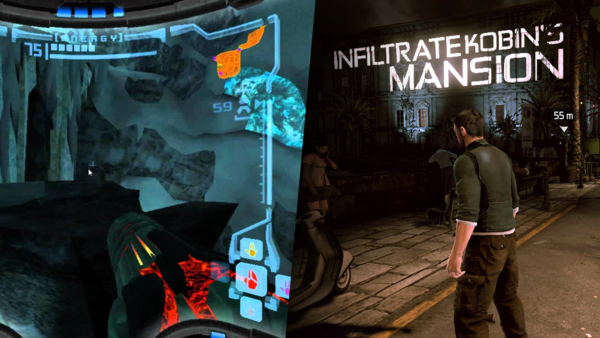The Evolution Of Video Game UI
Diegetic UI

Sometimes a video game does something different with your HUD. Either you get a little less present on your screen, or you have absolutely nothing at all. Aforementioned titles have given you your chambered ammunition count on the weapon itself, where some have done more to achieve less non-diegetic text floating about your peripheral vision. As if being followed by a projector drone, Sam Fisher knows what to do in Splinter-Cell: Conviction since his objectives are being splayed out on his surroundings in eight-foot high letters. Other titles get away with what appears to be a bog-standard, yet diegetic UI by giving the player a helmet. Though it shows everything they're used to, the character in-game can technically see it all too, taking the 'being in the protagonist's shoes' to a whole new level. The Metroid Prime series does it, as does Star Wars: Republic Commando, and rather aptly, Iron Man VR. You could argue that any title featuring the player in a helmet does the same.
Some titles incorporate your health bar into your character itself, notably Dead Space’s Resource Integration Gear, or RIG. Appearing as a glowing tube along your avatar’s spine, it was still very much a simple health bar, but done very differently. The likes of Call of Duty do away with statistics, bars, or anything regarding their health system, albeit in a handful of modern titles. Taking damage would begin to desaturate your display, and/or start covering your peripheral vision in lashings of raspberry jam. Diving behind cover would slowly replenish your health, with both the jam and muffled audio clearing to give you the go-ahead to dive back into battle.
But what about the times when diegetic is all there is? There's no immersion-breaking way to just plonk some text or graphics in front of the player? Virtual Reality. As a new medium within video games, developers are still experimenting with how information is relayed to the player. The aforementioned Iron Man VR gets a free pass since the idea of Tony Stark's helmet having a HUD means the usual display of compasses, numeric stats, and the like are canonically present. But what about when titles don't have the luxury? You may get floating text accompanying your weapon like in Fallout 4 VR, or your weapon itself has a visual depiction of your rounds left, such as the pistol in Half-Life: Alyx. Health may be depicted by a slowly reddening screen, or some kind of hand-mounted health bar. Or, the game could give you nothing. Superhot VR is a one hit kill, and you only know how many rounds you don't have when the weapon goes click.